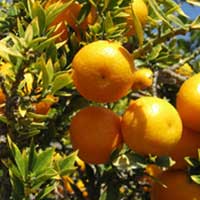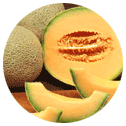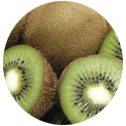 Full List of Fruits
Full List of Fruits  Wild orange fruit
Wild orange fruitWild orange fruit
Scientific name - Capparis mitchelii
Widespread in western New South Wales, the wild orange is an Australian indigenous plant which falls into the category of tasty bush tucker food. Long before European arrival, native Australians made use of the fruit on a regular basis. With an opaque crown and profoundly creviced black bark, they are a tall shrub or small rounded tree that grows up to 5-8 meters in height. Unkempt and thorny, the young plants are quite difficult to handle on the other hand; older plants become more erect and have fewer thorns. Mid to late summer is the best time for the fruit.
Green when unripe, as the fruit ripens, it turns out to be very soft featuring yellow to orange in color and has a great aromatic smell. Sometimes they are purplish or dull orange in color, soft to touch, they are generally about 4- 7cm across and the yellowish flesh is the one to be consumed in that. Having firm leaves, they are dull green in color and are oval in shape, 2-6cm x l-3cm; clothe the woolly, spiny branches. Although a bit astringent, they are appetizing to taste, the skin of the fruit should be peeled off before eating and they are bitter to taste. Seeds of the fruit should also be removed from the flesh. The fruit can either be had together with desserts or eaten raw; it can also be added to dishes like curries, rice and couscous.
![]() Nutritional Value of Wild orange
Nutritional Value of Wild orange
| Amount per Serving | % Daily Value |
| Total Fat 1.3g | 2% |
| Saturated Fat -1g | -5% |
| Cholesterol -1mg | -0% |
| Sodium 7mg | 0% |
| Total Carb 16.4g | 5% |
| Dietary Fiber 11.4g | 46% |
| Sugars -1g | |
| Protein 5.8g | 12% |
| Vitamin A -0% | Vitamin C 123% |
| Calcium 5% | Iron 4% |
![]() Health Benefits of Wild orange
Health Benefits of Wild orange
One of the most important benefits of wild orange is that it is loaded with vitamin C, which helps to boost the immune system and protect against common illnesses. Vitamin C also helps to reduce inflammation, as well as fight off free radicals in the body. Additionally, vitamin C is an important nutrient for collagen production, which helps to keep skin looking young and healthy.
Wild orange is also high in dietary fiber, which helps to promote digestive health and regularity. Fiber helps to slow down the absorption of sugar in the bloodstream, which helps to regulate blood sugar levels. Eating wild orange is also beneficial for heart health, as it is high in potassium, which helps to reduce blood pressure.
Wild orange is also a great source of antioxidants, which help to protect cells from damage caused by free radicals. Antioxidants can help to reduce the risk of certain types of cancer, as well as slow down the aging process. Wild orange is also high in folate, which helps to reduce the risk of birth defects in pregnant women.
Overall, wild orange is an excellent source of numerous health benefits. It is packed with vitamins, minerals, and antioxidants that can help to boost the immune system, protect against common illnesses, and reduce the risk of certain types of cancer. Eating wild orange is a great way to get a variety of essential nutrients and enjoy a tasty snack at the same time.Offering the most dynamic fragrances of essential oils, wild oranges have a combination of proven antifungal, antibacterial, and antidepressant properties which make them one of the most powerful and perfumed oils to make use of. They are known for relieving stress and are an excellent source of sterilizing and killing fungus and pathogens. Predominantly used in the treatment of anorexia, they are also used as an anti-cancer agent. They are highly suggested to use during the early stages of cold and flu. They are both stimulating and uplifting, while being sedative by instilling feelings of peace.
Pervasively identified for its economic, conservation and cultural value, Capparis mitchelii is naturally drought resistant and it is this factor that makes them suitable for use in Australian agro-forestry. Acting as a vital support for the arid ecosystem, where it performs the host tree for the Caper White butterfly and shade provider from heat. More to the point, the plant has all potentialities for improving diets, due to its high level of vitamin C. With all that said, they are listed as one of 21 native species which have been considered as valuable plants in the confectionery, flavoring and preservative industries. As a matter of fact, it is an important Australian native plant worthy of development and cultivation.
Wild oranges can be grown outdoors in warm climates where temperatures do not fall below 25°F (7°C). They require a well-draining, sandy soil that is slightly acidic and rich in organic matter. The trees should be planted in a sunny spot and provided with regular water and fertilizer. Pruning of wild orange trees is recommended to maintain their shape and encourage a higher yield of fruit.
When caring for wild oranges, it is important to protect the tree from pests and diseases. Regularly inspect the trees for signs of pests or diseases, and treat them appropriately. Prune branches that are infected or infested with pests. Regularly monitor the soil, and adjust the nutrients and irrigation accordingly.
Harvesting wild oranges can take place from October to December. The fruit should be picked when it is ripe, as unripe fruits have a bitter taste. The fruits can be eaten fresh or used to make juice and other sweet treats.
Wild oranges are a great addition to any garden or orchard. With proper care, they can provide a bountiful harvest of sweet, juicy oranges.
The plant best thrives in a full sun position and it requires a well-drained soil and can't tolerate bad drainage. Sow seed in warmer parts of the year 1-2cm less than the facade of a good seed raising mix. It is good to keep moist until germination in the first 1-6 weeks. During the warmer months, it requires regular watering and it is said to respond well when watered during the colder months in most areas. They are frost and drought hardy.


















